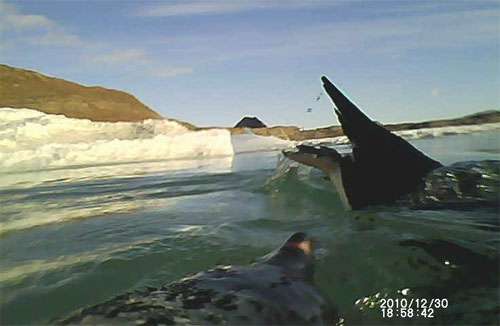Credit: PNAS
(Phys.org)—Japanese researchers have taken the science of studying an animal in its natural environment a step further by attaching a camera and accelerometers to Adelie penguins as they forage for food off the waters of Antarctica. In their paper published in the Proceedings of the National Academy of Sciences, the researchers describe how they were able to watch the intimate details of the foraging habits of the penguins in ways never before seen.
Prior to this effort, other scientists have attached tiny cameras to the backs of penguins and then studied the video to learn more about their underwater habits. Other researchers have also attached different types of sensors to penguins to try to understand what happens as an individual hunted. This new research combines both ideas to provide a unique and clear picture of how a penguin's body moves as it swims and catches food.
Non-foraging shallow dives. Credit: PNAS
Just two sources make up most of an Adelie's diet – shrimplike creatures called krill and bald notothens, a type of fish. To catch them, the penguins must be both quick and agile. To find out just how they go about their foraging, the researchers affixed small cameras to the bodies of 11 of the penguins along with two accelerometers, one on the head and one on the back – they allow the researchers to record the different ways the penguin moves. In so doing they were able to gather 85 minutes of data for each penguin. Afterwards, in studying the video and comparing it with data from the accelerometers, the researchers were able to gain a very clear understanding of how the penguins caught their prey.
Sub-ice fish (Pagothenia borchgrevinki) capture. Credit: PNAS
In their study, the researchers learned that the penguins catch fish close to the surface, but must dive deeper to catch krill and that fish provide a more steady diet than krill. They also learned that the penguins move beneath their prey, preferring to catch it while moving upwards and in the case of krill, also turning their heads very quickly at the last second as a means of striking. In watching the penguins in action, the team also learned that the penguins are remarkably efficient foragers – none of them ever once returned to the surface without having caught the prey they were after. Antarctic silver fish (Pleuragramma antarcticum) capture in a school. Credit: PNAS
More information: "Linking animal-borne video to accelerometers reveals prey capture variability," by Yuuki Y. PNAS, 2013. www.pnas.org/cgi/doi/10.1073/pnas.1216244110
Journal information: Proceedings of the National Academy of Sciences
© 2013 Phys.org






















